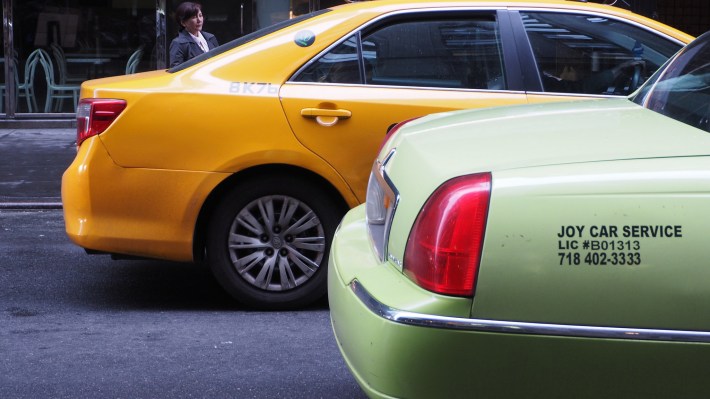The de Blasio administration's proposed slowdown in new for-hire vehicle licenses for a one-year study period could be the opening move in a major rewrite of the rules governing the city's taxi and livery industry. The current system is an anachronism, and a big overhaul could harmonize the city's growing array of medallion taxis, green cabs, and Uber-type services in a way that lessens the need for private car ownership without contributing to congestion in the city core. But what, exactly, would that system look like?

It's a big task. Set aside, for a moment, the merits of a one-year cap on new for-hire cars. Let's start with the basics and go from there.
First off, New Yorkers use car services in vastly different ways. "New York City is two worlds," said Elliott Sclar, a city planning professor and director of the Center for Sustainable Urban Development at Columbia University's Earth Institute. "There’s Manhattan below 96th Street, and then there’s the rest of the city."
Outside the Manhattan core, car service options consist mainly of black cars and, more recently, green boro taxis. They tend to serve journeys that would be indirect and slow using transit. And congestion outside the city center is mainly due to private vehicles, not car services, so there's not much reason to discourage new taxis and black cars in most of the city.
Meanwhile, sky-high demand for travel in the Manhattan core is like a black hole sucking in for-hire drivers from across the city. Most taxi customers in or near the Manhattan core have a decent transit alternative, but they hire a car for speedier service or a more luxurious ride. According to TLC, 94 percent of yellow taxi pick-ups are either in Manhattan or at the airports, and the fastest-growing for-hire companies, powered by e-hail apps like Uber, do 72 percent of their business in Manhattan south of 60th Street.
The result is a crush of taxis and black cars driving around the central business district.
The de Blasio administration says it needs to slow down the increase in for-hire licenses to study congestion, but given the large campaign contributions the mayor received from the yellow taxi industry, the surface explanation is hard to swallow. In the end, the one-year cap on new for-hire licenses might have more to do with navigating tricky political waters, where the administration faces hard-charging Uber on one side and medallion interests on the other, than with alleviating Midtown congestion.
It's possible that the city will seek to create a uniform set of regulations governing all types of for-hire services. “I can’t rule that out,” TLC Commissioner Meera Joshi said after a City Council hearing last month. “From a consumer’s perspective, that’s the way it’s going to look, and the regulatory and legal frameworks behind that may eventually mirror what consumers see.”
The cap on Uber and other for-hire competitors "might be a way to get medallion owners on board with this process" of rethinking taxi regulations, said Rich Barone, director of transportation programs at the Regional Plan Association. "There’s a lot of stakeholders, a lot of voices here. A lot of powerful voices."
Ultimately, the need to manage Manhattan congestion may still be a big factor in the city's long-term regulation plan. “The reason we have medallions in the first place is that the taxis were choking the city in the 1930s," Sclar said.
“I do think we’re going to have to look at numbers here," Barone said, "to see what we think is a healthy number of vehicles the core can handle."
Even with fewer regulatory distinctions between types of taxis, the city could pursue a number of strategies to address differences between the core and the outer boroughs. Options include capping the number of for-hire vehicles that can pick up fares in the core while allowing unlimited growth in outlying areas, or adding high surcharges to trips in the core.
Another major question that's bound to surface is how and whether to regulate prices. Will TLC set how much each trip costs, like with yellow taxis, or will it allow car services to compete on price, like Uber does?
Before it can rewrite the rules, the city needs to crunch data and get a handle on how car services are being used.
Bruce Schaller served as traffic and planning commissioner at NYC DOT before departing city government last year. His consulting work now includes taxi policy analysis outside New York. "Until we have a much better idea of what’s happening, we’re just kind of throwing darts in the dark in terms of talking about policy options," he said. "The question to ask is what we want this to look like five years from now, and that’s going to take a bunch of analysis and some careful thinking."





